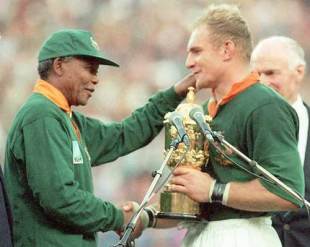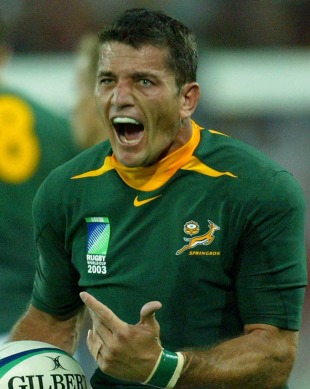|
South Africa Rugby
Captains reflect on Springbok's progress
Stephen Nell
March 28, 2013

Francois Pienaar captained South Africa to the 1995 World Cup - the first the Springboks had competed in
© Getty Images
Enlarge
The gates to international competition were re-opened for the Springboks after unity was achieved in South African rugby in 1992, but in truth at the time it was no more than a signed document. It was still 15 white Springboks that took the field to face the All Blacks at Ellis Park and you would have struggled to spot a black spectator outside the VIP-suite. The flags waved meanwhile were those of a government that perpetuated crimes against humanity. The present day government has evidently set the country on a fresh route to moral bankruptcy, but South African rugby is far down the road in terms of healing. That much was evident when 43 national captains, "past and present, across the colour line" gathered in Cape Town to provide their hand prints for the Springbok Experience museum at the city's famous Waterfront. Its doors will open on September 24, officially Heritage Day in South Africa, but considered by many folk to be National Braai Day. In other words: An opportunity for a barbecue. The present-day Springboks will have a barbecue on the lawn outside the museum on the day of the opening. It will be a team that is still predominantly white, but the wheels are turning, admittedly sometimes too slowly, and it is probably a matter of time before the Rainbow Nation is better reflected in the green and gold. The positive thing about this week's gathering was that the national captains enjoyed interacting and sharing their stories with one another. There were no arguments about who would have been the better player in his position had the playing fields been level. Rather, an atmosphere of mutual respect hung in the air. This, of course, included the pronounced differences among the erstwhile non-white bodies. The divisions between the pre-apartheid South African Rugby Union (a body with a non-racial constitution and actively involved in struggle politics) and the South African Rugby Federation (a coloured body that sought to work with the white governing body towards non-racialism) continued to punctuate the air in politics at the diverse and influential Western Province Rugby Union.
But rugby drew everyone together as they provided their hand prints that will be cast into bronze and put on display later this year. Many of these players, of course, already knew one another and had briefly played together or served together on committees, but there was also a lot of first contact. "I think politicians can come and learn from us," said former Federation icon Dougie Dyers. "We are joined by the hip in our love for our country and secondly for rugby. It's fantastic that we could all get together for healing. The big thing that needs to be recognised is that everyone made a contribution." Dyers played in the Federation side that went down 6-11 to England in 1972. One of the players, Green Vigo, was signed up for rugby league side Wigan that very same day. Dyers also led a Proteas-team on a tour of Britain the same year. The Federation went on to produce great players, with Springboks Chester Williams and Errol Tobias the highest profile. Francois Pienaar, who captained the Springboks when they captured the World Cup in 1995, also praised the huge significance of the get-together. "There are a lot of South African rugby stories that haven't been told and it's important that they are. That is what the museum will do," he said. "Springbok rugby fanned the flames of division among people in the apartheid years, but later brought them together. I've met new people here and it's difficult to put into words. There is so much value in this. "There is immediately a bond once you shake hands and tell a few stories, because it's all under the banner of rugby." A touch of sadness punctuated the air as Springbok great Joost van der Westhuizen was helped onto the stage by former team-mates Pienaar and Gary Teichmann. As he did so the crowd at the Waterfront Amphitheatre rose to its feet to welcome the World Cup-winning scrum-half. "I think people here recognised what Joost did on the field. I don't think there was a better scrumhalf," said Pienaar. Corne Krige described Van der Westhuizen as the "fighter among the fighters," and said that there had been a "lump in my throat."

Joost van der Westhuizen captained the Springboks 10 times, winning eight matches
© Getty Images
Enlarge
Of course there was good humour in abundance. Naas Botha of all people "a great Springbok fly-half, despised in the Cape when he wore the colours of the Blue Bulls but loved in equal measure when he wore green and gold," received the biggest cheer of the day. "I think it's just because I'm not playing anymore. I can at least say now that I enjoyed a trip to Cape Town," he laughed. "It's not about the captains," he added, "rather it's about our heritage. I felt that the new South Africa at one stage forgot where it came from. We're here because of history, however turbulent that history may be. We need a museum because a lot of people worked very hard to get us here. Every side's story will be told and it will be fascinating. There is history I didn't know anything about. It's important that young people learn the history that paved the way for them." Salie Fredericks, who played under the non-racial SARU-banner from 1963 to 1970, also emphasised that divisions had been healed. "Our country has always been a little divided," he said. "Nelson Mandela made a lot of things right, but there are still too many of us who cheer for the All Blacks. I was one of them myself at one stage." Peter Jooste, who was a non-racial SARU great and has subsequently become the Springbok convenor of selectors, described this week's initiative by the South African Rugby Union as one of the biggest gestures for promoting unity. "It makes you realise that all the sacrifices were worthwhile. So many people gave up so much. You can now get closure." © ESPN Sports Media Ltd.
| |||||||||||||||
Live Sports
Communication error please reload the page.
-
Football
-
Cricket
-
Rugby
-
- Days
- Hrs
- Mins
- Secs
F1 - Abu Dhabi GP
Abu Dhabi Grand Prix December 11-131. Max Verstappen ()
2. Valtteri Bottas (Mercedes)
3. Lewis Hamilton (Mercedes)
4. Alexander Albon ()
5. Lando Norris ()
6. Carlos Sainz Jr ()
-
ESPNOtherLive >>
Darts - Premier League
Golf - Houston Open
Snooker - China Open
Tennis - Miami Open

